CHEVROLET TRACKER 1995 Owners Manual
Manufacturer: CHEVROLET, Model Year: 1995, Model line: TRACKER, Model: CHEVROLET TRACKER 1995Pages: 354, PDF Size: 18.24 MB
Page 221 of 354
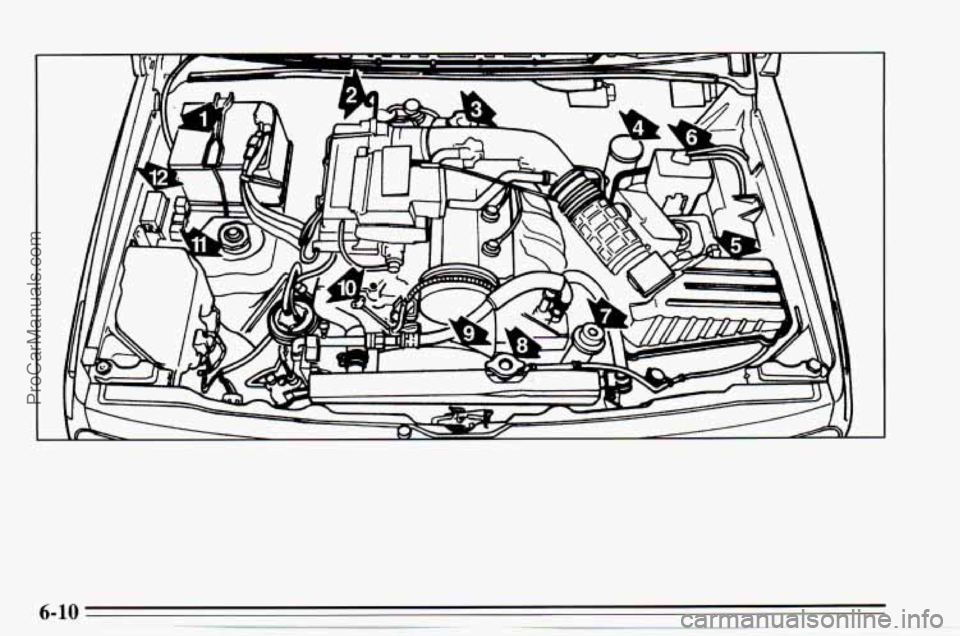
ProCarManuals.com
Page 222 of 354
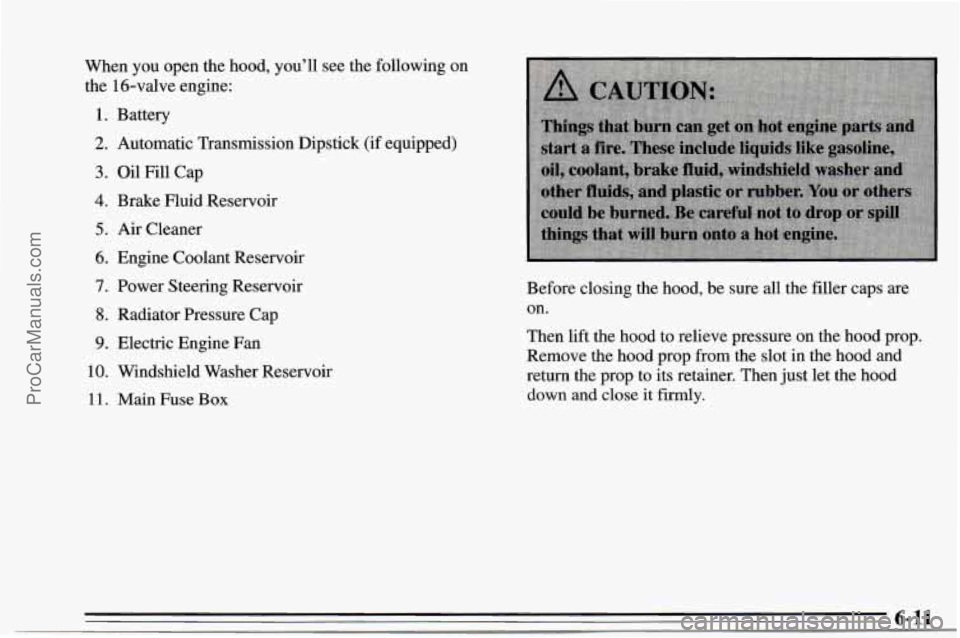
When you open the hood, you’ll see the following on
the 16-valve engine:
1. Battery
2. Automatic Transmission Dipstick (if equipped)
3. Oil Fill Cap
4. Brake muid Reservoir
5. Air Cleaner
6. Engine Coolant Reservoir
7. Power Steering Reservoir
8. Radiator Pressure Cap
9. Electric Engine Fan
10. Windshield Washer Reservoir
11. Main Fuse Box Before
closing the hood, be sure all the filler caps are
on.
Then lift the hood to relieve pressure on the hood prop.
Remove the hood prop from the slot in the hood and
return the prop to its retainer. Then just let the hood
down and close it firmly.
6-11 ProCarManuals.com
Page 223 of 354
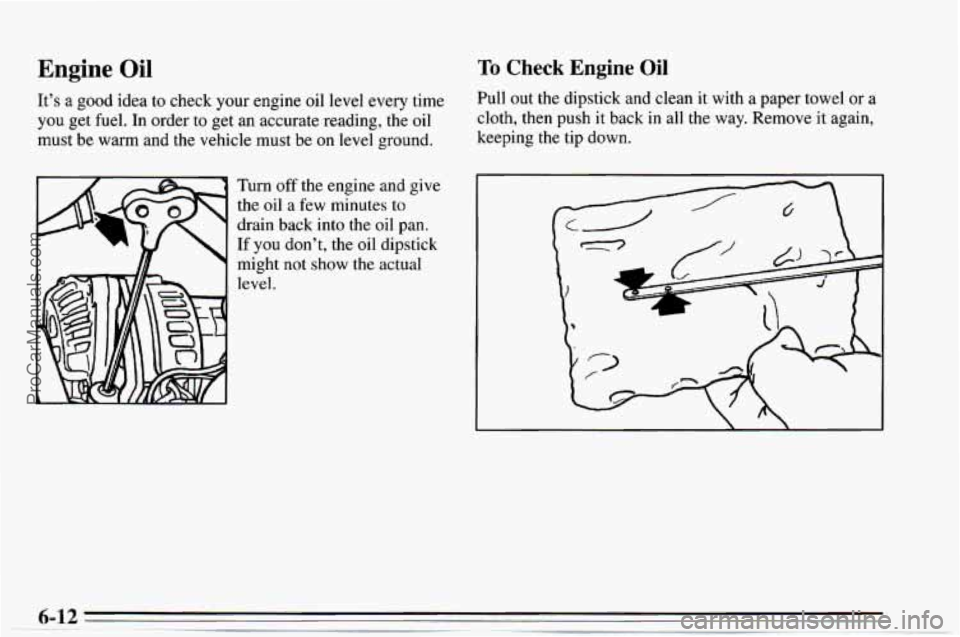
Engine Oil
It’s a good idea to check your engine oil level every time
you get fuel. In order to get an accurate reading, the oil
must be warm and the vehicle must be
on level ground.
Turn
off the engine and give
the oil a few minutes to
drain back into the oil pan.
If
you don’t, the oil dipstick
might not
show the actual
level.
To Check Engine Oil
Pull out the dipstick and clean it with a paper towel or a
cloth, then push it back in all the way. Remove it again,
keeping the tip down.
t
ProCarManuals.com
Page 224 of 354
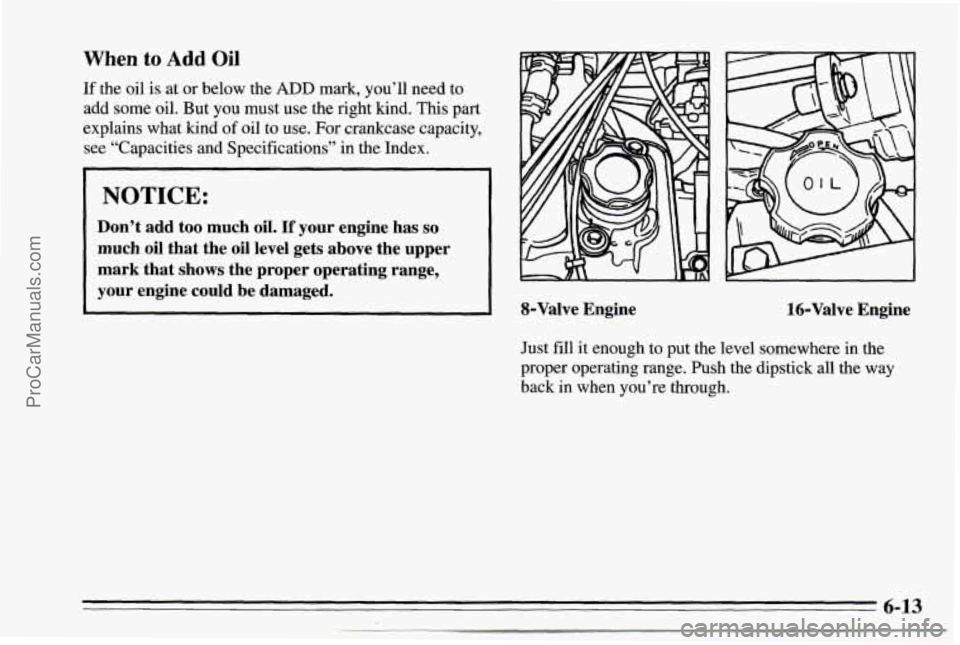
When to Add Oil
If the oil is at or below the ADD mark, you’ll need to
add some oil. But you must use the right kind. This part
explains what kind
of oil to use. For crankcase capacity,
see “Capacities and Specifications” in the Index.
Don’t add too much oil. If your engine has so
much oil that the oil level gets above the upper
mark that
shows the proper operating range,
your engine could be damaged. 8-Valve Engine 16-Valve Engine
Just fill it enough to put the level somewhere in the
proper operating range. Push the dipstick all the way
back in when you’re through.
6-13
ProCarManuals.com
Page 225 of 354
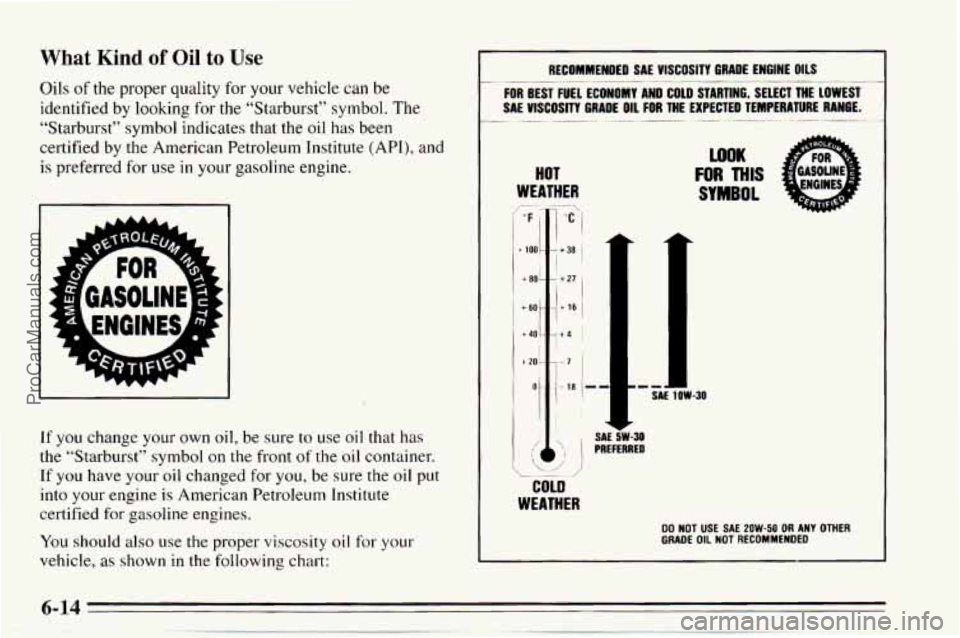
What Kind of Oil to Use
Oils of the proper quality for your vehicle can be
identified by looking
for the “Starburst” symbol. The
“Starburst” symbol indicates that the oil has been
certified by the American Petroleum Institute
(API), and
is preferred for use
in your gasoline engine.
If you change your own oil, be sure to use oil that has
the “Starburst” symbol on the front of the oil container.
If you have your oil changed for you, be sure the oil put
into
your engine is American Petroleum Institute
certified
for gasoline engines.
You should also use the proper viscosity oil for your
vehicle,
as shown in the following chart:
RECOMMENDED SAE VISCOSITY GRADE ENGINE OILS
FOR BEST FUEL ECONOMY AND COLD STARTING, SELECT THE LOWEST
SAE VISCOSITY GRADE OIL FOR THE EXPECTED TEMPERATURE RANGE. __ ~ ~ .~
HOT
WEATHER --
+ 80
+ 60
t 20
-. -. ./ \.. ~ ,.,’ ,
COLD
WEATHER
LOOK
FOR THIS
SYMBOL
SAE ZW-30 PREFERRED
DO NOT USE SAE 2OW-50 OR ANY OTHER
GRADE OIL NOT RECOMMENDED
6-14
ProCarManuals.com
Page 226 of 354
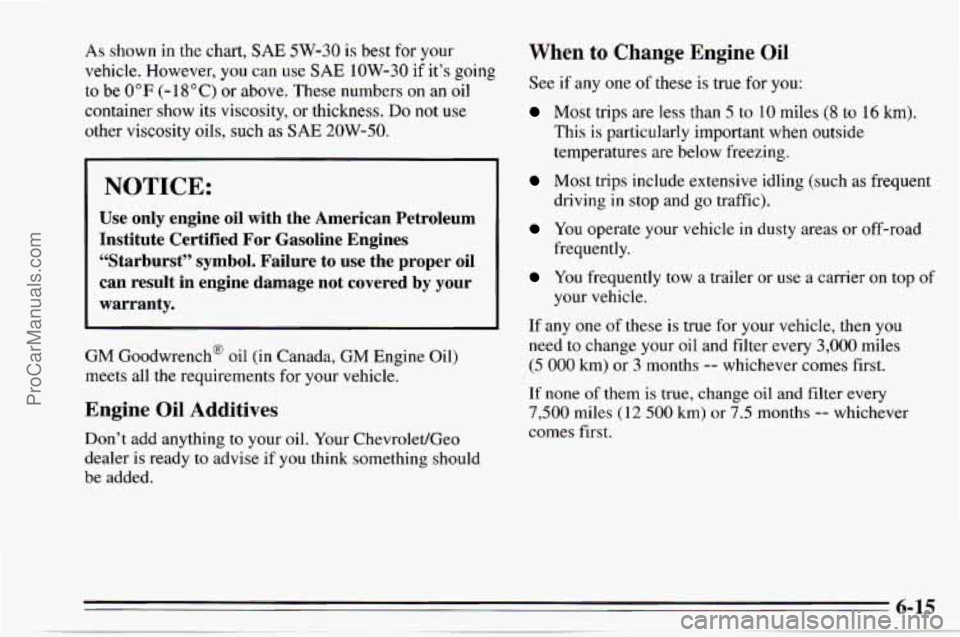
As shown in the chart, SAE 5W-30 is best for your
vehicle. However, you can use
SAE 10W-30 if it's going
to be 0°F (-18°C) or above. These numbers on an oil
container show its viscosity, or thickness.
Do not use
other viscosity oils, such
as SAE 20W-50.
NOTICE:
Use only engine oil with the American Petroleum
Institute Certified For Gasoline Engines
"Starburst" symbol. Failure to use the proper oil
can result in engine damage not covered by your
warranty.
GM Goodwrench@ oil (in Canada, GM Engine Oil)
meets all the requirements for your vehicle.
Engine Oil Additives
Don't add anything to your oil. Your Chevrolet/Geo
dealer is ready to advise if you think something should
be added.
When to Change Engine Oil
See if any one of these is true for you:
Most trips are less than 5 to 10 miles (8 to 16 krn).
This
is particularly important when outside
temperatures are below freezing.
driving in stop and
go traffic).
Most trips include extensive idling (such as frequent
You operate your vehicle in dusty areas or off-road
You frequently tow a trailer or use a carrier on top of
frequently.
your vehicle.
If any one
of these is true for your vehicle, then you
need to change your oil and filter every 3,000 miles
(5 000 km) or 3 months -- whichever comes first.
If none of them is true, change oil and filter every
7,500 miles (12 500 km) or 7.5 months -- whichever
comes first.
ProCarManuals.com
Page 227 of 354
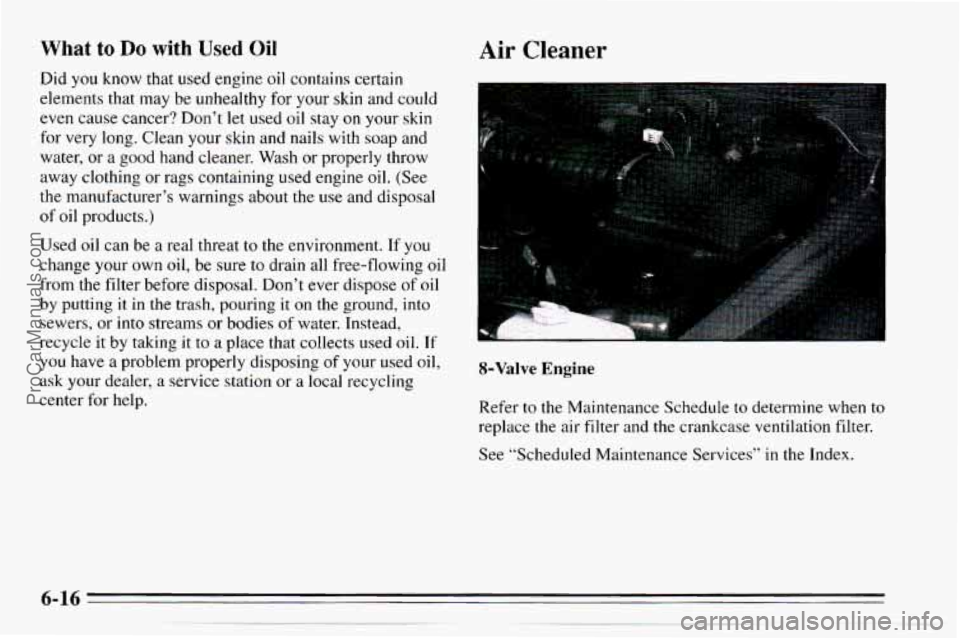
What to Do with Used Oil
Did you know that used engine oil contains certain
elements that may be
unhealthy for your skin and could
even cause cancer? Don’t let used oil stay
on your skin
for very
long. Clean your skin and nails with soap and
water, or a good hand cleaner. Wash or properly throw
away clothing or rags containing used engine
oil. (See
the manufacturer’s warnings about the use and disposal
of oil products.)
Used oil can be a real threat to the environment. If
you
change your own oil, be sure to drain all free-flowing oil
from the filter before disposal. Don’t ever dispose
of oil
by putting it
in the trash, pouring it on the ground, into
sewers, or into streams
or bodies of water. Instead,
recycle it by taking it
to a place that collects used oil. If
you have a problem properly disposing of your used oil,
ask your dealer, a service station
or a local recycling
center for help.
Air Cleaner
8-Valve Engine
Refer to the Maintenance Schedule to determine when to
replace the air filter and the crankcase ventilation filter.
See “Scheduled Maintenance Services” in the Index.
ProCarManuals.com
Page 228 of 354
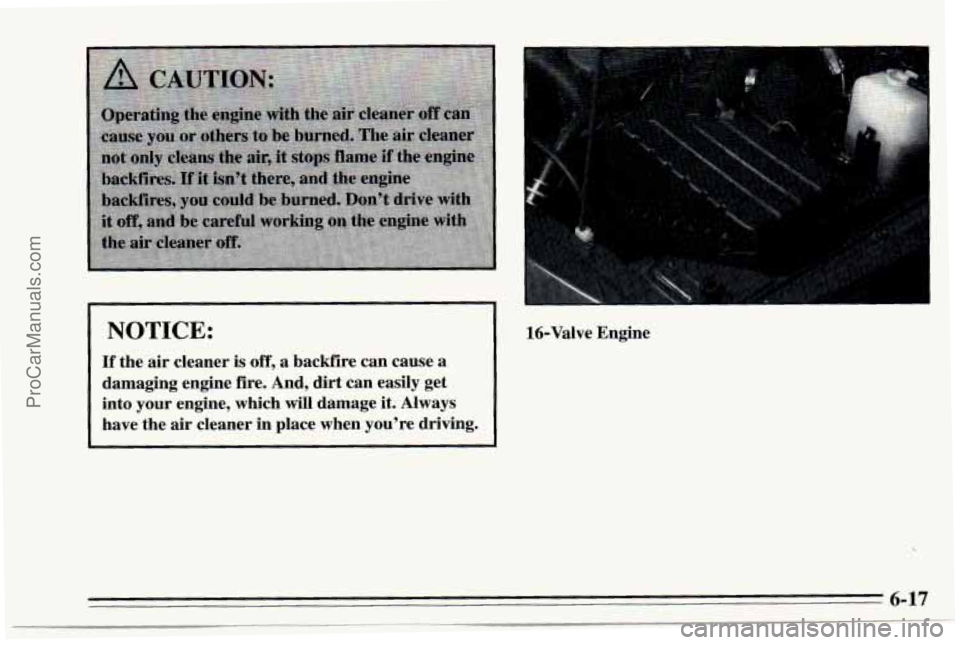
NOTICE:
If the air cleaner is off, a backfire can cause a
damaging engine fire. And, dirt can easily get
into your engine, which will damage it. Always
have the air cleaner in place when you’re driving. 16-Valve Engine
6-17
ProCarManuals.com
Page 229 of 354

Air Filter Replacement (8-Valve Engine) Air Filter Replacement (16-Valve Engine)
To check or replace the filter:
1. Remove the screws on the cover.
2. Lift up the cover.
3. Pull out the filter.
To check or replace the filter:
1. Remove the screws on the cover.
2. Lift the cover up.
3. Pull out the filter.
6-18
y__.._. ProCarManuals.com
Page 230 of 354

Automatic Transmission Fluid
When to Check and Change
A good time to check your automatic transmission fluid
level is when the engine oil is changed. Refer to the
Maintenance Schedule to determine
when to change
your fluid. See “Scheduled Maintenance Services”
in the
Index.
How to Check
Because this operation can be a little difficult, you may
choose to have this done at your Chevrolet/Geo dealer
Service Department.
If you do it yourself, be sure to follow all the
instructions here, or you could get a false reading on the
dipstick.
NOTICE:
Too much or too little fluid can damage your
transmission.
Too much can mean that some of
the fluid could come out and fall on hot engine
parts or exhaust system parts, starting a fire. Be sure to get an accurate reading if you check your
transmission fluid.
Wait at least 30 minutes before checking the
transmission fluid level if you have been driving:
0 When outside temperatures are above 90°F (32°C).
At high speed for quite a while.
0 In heavy traffic -- especially in hot weather.
0 While pulling a trailer.
To get the right reading, the fluid should be at normal
operating temperature, which is
180” F to 200” F
(82°C to 93°C).
ProCarManuals.com